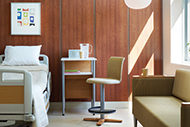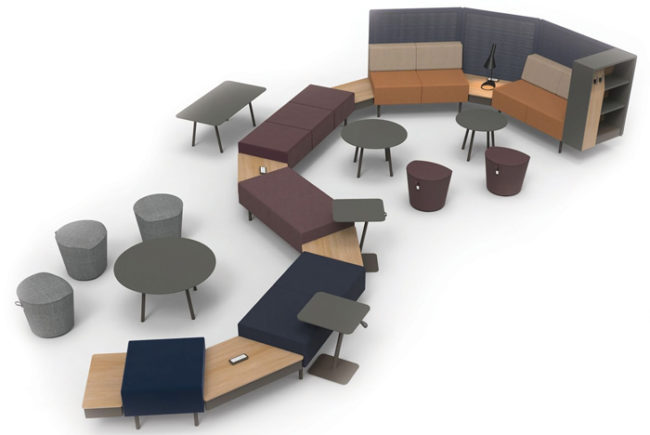Given the impact of satisfaction ratings on payments to hospitals, the patient experience is front and center in many discussions among health care providers, and they are leaving no stone unturned as they work to gain patient loyalty. The latest health care furniture is designed to improve the hospital experience for patients and employees — creating family-friendly environments while preventing the spread of infection through effective yet easy cleanability.
Key considerations
Some key considerations for specifying and purchasing health care furnishings include:
Cleanability. In the fight to prevent health care-associated infections (HAIs), manufacturers are focusing on infection prevention in furniture designs. Bacteria can grow and thrive in cracks and crevices, and spread to patients and their guests. Thus, designing furniture that is nonporous is better for patients and for the hospital’s bottom line.
You may also like |
| Furnishings that accommodate technology |
| Systems seek flame-retardant-free furniture |
| Kaiser bans 13 antimicrobial additives from surfaces |
| |
Cleanability isn’t just about the appearance of stains or dirt. It encompasses the much larger domain of infection control, according to Rob Heitmeier, general manager, Steelcase Health, Grand Rapids, Mich. “Infection control has risen to the top of the cleanability criteria for many hospitals. It drives discussions around health care furniture features such as clean-out spaces and arm caps, but also dives further into surface material selection, the use of antimicrobials and cleaning protocols,” he says.
Keeping surfaces clean is paramount to helping hospitals prevent the spread of HAIs, according to manufacturers. To that end, Kwalu, Atlanta, has developed the Carrara guest chair. The back of the chair is upholstery-free and the frame can be cleaned with all 2014 EPA-registered antimicrobial products effective against Clostridium difficile spores. “As styles change or vinyl fails, hospitals can change the chair’s seat at little cost on-site,” says Sylvia Nash, vice president, health care sales.
There are two key elements to furniture cleanability, says Ed Miles, director of health care, GLOBALcare, Marlton, N.J. The first is utilizing the appropriate textile. “The current trend is toward health care vinyl and polyurethane textiles, which are durable, moisture-proof and easy to clean. The material should include anti-stain and antimicrobial qualities,” he explains.
“The second element is the chair itself. The arm caps should be one piece and not layered with different materials. This eliminates cracks and crevices that are hard to clean. The seat and seat back should have a clean-out space for easy housekeeping and wipe-down.”
The chair framework should be designed for easy cleaning as well, he adds. The seat should not be tight to the chair’s side frame, and should allow for a 360-degree wipe-down. The framework should be fastened to the arm and/or leg frames with minimal catchalls and allow for easy, accessible wipe-down.
Ergonomics. When it comes to improving ergonomics, it is important to remember that no two patients are alike. A patient’s height, weight, strength, dexterity and other factors determine his or her unique ergonomics. “We design for ‘the middle’ of the potential patient population and then offer a wide range of features, options and accessories that allow caregivers to customize solutions for their patient population,” says Angel Ness, contract sales manager, Champion Manufacturing Inc., Elkhart, Ind.
Improving ergonomics for hospital staff means designing furniture that supports efficiencies in workflow, while protecting employees from physical stress and injuries. “For example, a chair designed with a slightly higher seat reduces the need to bend,” Ness adds. “This is very important when you consider how many times a nurse bends her back to assist patients during a shift. A few inches can make a big difference. That is why Champion’s Classic, Ascent and Ascent II product lines feature higher seat dimensions.”
Ergonomic solutions in the health care environment must consider the various ways that furniture may be used, furniture experts agree. In the past, the focus was on the patient, but today more furniture solutions accommodate the caregiver as well.
“When product design does not consider the transfer of patients in and out of a chair, for example, there is an increased risk of an injury to the caregiver,” says Brian Trego, vice president, product management and development, the HON Co., Muscatine, Iowa. “In addition, the uses of technology throughout facilities will continue to challenge designers to implement ergonomic solutions. Where caregivers were once tethered to a centralized station, hospital areas are now designed with decentralized models of care.”
IOA Healthcare Furniture, Thomasville, N.C., offers CONNECT patient lift recliners that enable safe interaction between caregivers and patients. The smooth movement of the recliners allows caregivers to easily elevate and recline patients. Reducing the need to manually handle the patient helps to decrease the risk of injury. Also, elevation to 31 inches eliminates the need for a separate exam table. A wide range of options is available to customize the recliners to specific health care applications, the company reports.
Bariatrics. Given the growing number of obese and overweight people in the general population, bariatric furniture solutions are important today. Deborah Breunig, R.N., BSN, EDAC, vice president of sales and marketing, health care market, KI Furniture, Green Bay, Wis., says that safety is the No. 1 consideration when designing for this market.
“KI’s bariatric seating safely accommodates a user weighing up to 750 pounds — addressing safety in ingress and egress along with structural integrity that visually assures the user. KI also addresses the issue of dignity, and designs solutions that integrate seamlessly within all furniture collections. Universal design is the ultimate consideration — solutions that meet the needs of all users, not segregating users based on size,” she notes.
Furniture designed for the bariatric patient population needs to accommodate both the weight and the frailties of the patient — for example, how a patient fits between fixed points, such as chair arms. “A piece of furniture that is sized incorrectly for the patient can create pressure points on already fragile skin, which can lead to skin ulcers. Furniture manufacturers cannot underestimate the impact their products can have on this segment of the patient population,” Ness says.
Sustainability. Designing and building environmentally friendly furniture is now standard in the health care industry, according to Kimberly Montague, AIA, EDAC, LEED BD+C, knowledge program lead, Herman Miller.
“Sustainability, once a ‘nice to have’ in health care design, has become something that architects and designers expect from manufacturers. To that end, all Herman Miller products incorporate Design for the Environment (DfE) considerations,” Montague says.
DfE protocol evaluates new product designs in four key areas.
• Material chemistry and safety of inputs. What chemicals are in the materials, and are they the safest available?
• Disassembly. Can products be taken apart at the end of their useful life to recycle the materials?
• Recyclability. Do the materials contain recycled content and, more importantly, can the materials be recycled at the end of the product’s useful life?
• Life-cycle assessment. Is the product optimized based on the entire life cycle?
Family friendly. Creating family-friendly furniture for both the patient room and on the hospital floor is a trend that’s here to stay, and helps family members to feel comfortable during visits and long hospital stays. “Sofas and chairs that turn into beds at night are just one way that hospitals are supporting family members,” says Heitmeier. “Waiting areas can be transformed to create zones where family members can find comfort and be productive while waiting.”
Family-friendly solutions that provide intuitive features also are important, so that family members do not have to ask for assistance, adds Breunig. “For example, KI’s LaResta provides ample seating for three to four adults by day, but can easily convert to a sleepover configuration. Storage for personal items and bedding are provided, and power connections can be integrated.”
Within these new configurations, patient room design often features zones for the bed as well as gathering areas for family and friends. Of course, the overall square footage must be considered, experts agree. Facilities professionals need to look for flexible, adaptable furniture that can be used by both the patients and their loved ones.
“A recliner that converts to an overnight sleeper can accommodate both the patient and the family with one piece of furniture, one footprint in the room,” says Ness. “Champion’s Continuum recliner is a soft place to land for the patients and their guests, and goes from day to night seamlessly.”
CAMA Inc., an interior design lab and studio based in New Haven, Conn., recently introduced the Cama bed-chair, which allows families to sit alongside the patient while he or she is in bed. Seat height rises to 22 inches and allows for eye-to-eye contact and hand-holding reassurance, says Rosalyn Cama, FASID, EDAC, president.
“The Cama bed-chair is the answer to many parents we have interviewed over the years who want to cuddle with their hospitalized, bedridden children. The chair is designed for the family member to easily reach bed height and spend hours in comfortable positions. In addition, hip-hugger upholstery allows the family member to lean in toward the patient,” she says.
The design of the Ava recliner from Nemschoff, a Herman Miller company, reflects many of the above-mentioned trends, according to Gary Cruce, director of new product development for Nemschoff, Sheboygan, Wis. Development of the Ava recliner incorporated caregiver feedback at hospitals in Boston and Milwaukee. This real-world insight helped to shape development in three areas:
• Scale. A departure from the typical recliner aesthetic, Ava’s lean form is sized to move and operate easily, fit into smaller patient rooms and feel more like residential furniture.
• Personalized comfort and ergonomics. Sitting in the Ava wingback model provides a feeling of security for patients, while reverse recline and independent footrest controls increase comfort. Pivoting arms give caregivers better access and leverage, helping to minimize caregiver back injuries.
• Cleanability. In addition to optional MicrobeCare antimicrobial surface treatment, Ava is designed with enclosed casters and an open design between the junctures of the arms, back and seat to prevent debris from getting trapped, thus enhancing cleanability.
“What’s often different [from home furnishings] are the finishes used to ensure that the products are easy to clean and can withstand heavy-duty use,” says Trego. Of course, unlike home furnishings, furniture in health care facilities must complete rigorous testing. The challenge is to create products that welcome and comfort the user, but also meet cleanability and durability requirements.
The future of health care furniture will continue to prioritize the comfort and safety of the caregiver, patient and visitors, experts say.
Neal Lorenzi is a freelance writer based in Mundelein, Ill.
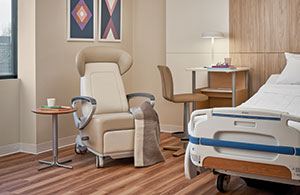 | Meeting needsThe needs of patients and caregivers are supported in this patient room, featuring the Ava wingback recliner paired with the touch-technology Ode lamp from Herman Miller. |
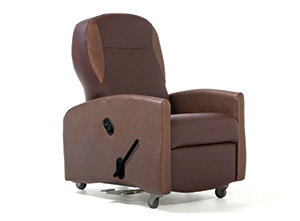 | Smooth transitionThe Continuum recliner converts to an overnight sleeper that can accommodate both the patient and family. |
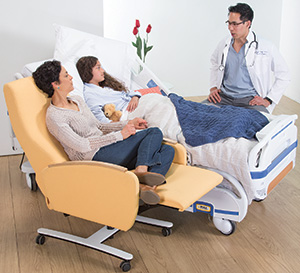 | Supportive environmentThis bed-chair allows family members to sit alongside the patient while he or she is in bed. |
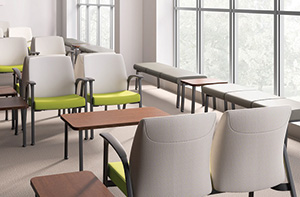 | Worth the waitSoothe guest chairs and benches can be configured to suit user space, style and functional needs. |
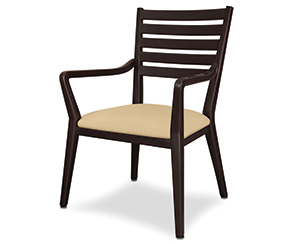 | Clean fixThe Carrara guest chair frame can be cleaned with all 2014 EPA-registered antimicrobial products effective against Clostridium difficile spores, thus reducing the spread of health care-associated infections. |
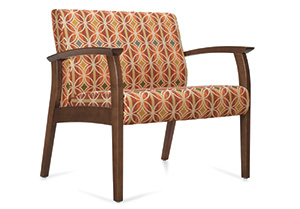 | Easy accessThe Primacare Series bariatric chair is designed with replaceable slipcover upholstery and 360-degree clearance around the seat, allowing for easy wipe-down. |
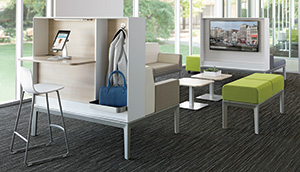 | Stay a whileThe Regard modular lounge system supports times of transition to make every moment more meaningful for patients and family members. |
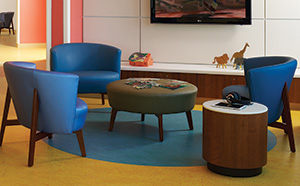 | Fit for allThe Arissa Collection is crafted to comfortably accommodate all users, regardless of their shape or size. |
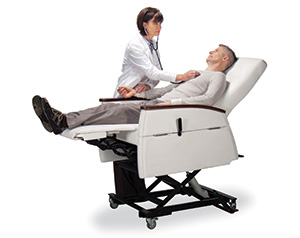 | Safety firstCONNECT patient lift recliners enable safe interaction between caregivers and patients. |



